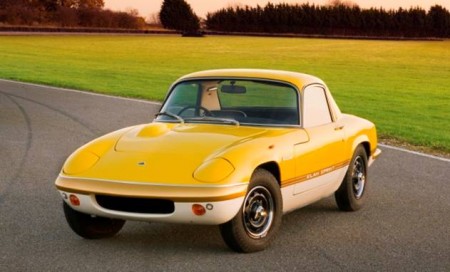Recalling Sixties spy-fi show The Avengers, the first thing men of a certain age remember is Mrs Peel’s black leather cat suit. But the character’s object of desire was her cute-as-a-button Lotus Elan.
The Elan was launched in October 1962 at the British Motorshow, just as the Sixties started swinging. Jaguar had launched the E-Type the previous year, and AC had the Cobra and Ferrari the GTO. Big, expensive, powerful muscles cars. The Elan was very different, and typically Lotus – ultra modern, lightweight, rapid and huge fun.
It summed up the Sixties: a playful topless two-seat ticket to freedom, it was technically innovative with the first backbone tube chassis of any road car, a fiberglass body, four-wheel independent suspension, 670kg with a peachy power-to-weight ratio, bang up-to-date styling beloved by Kings Road cruisers, and a liberating, rock n’ roll attitude.
It came with luxuries that were a rarity at the time, like electric windows, carpets, a heater, and in vogue wooden fascia, but it was still light enough on the scales to outrun other automotive competition – not to mention groupies.
The Elan Sprint, a more powerful 1973 alternative, could hit 60mph in 6.6 seconds, which even now would be considered respectably fast. Back then it was Neil Armstrong territory.
Its pop-up headlights could wink at admirers. It turned heads on Carnaby Street, where the Swinging Sixties embraced cool new design. As well as its turn on TV, defeating baddies and complimenting Diana Rigg’s risqué wardrobe, it found its way onto a magazine cover with Jimi Hendrix posing on the bonnet, and even inspired the lyrics to The Beatles’ A Day In The Life.
The Elan was Lotus’ biggest commercial success to that point, reviving a company stretched thin by the more exotic but in turn more costly to produce Elite. Four different series were produced up until 1973, including a coupe version. Seventeen thousand original examples, including the Elan +2, were produced.
The car was designed by Ron Hickman, who went on to make millions when he patented the Black & Decker WorkMate. He died last year, having earned an OBE for services to industrial innovation.
The Elan was the design inspiration for the Mazda MX-5, which was one of the biggest selling sports cars of the 1990s, and it’s clearly the mother of the Lotus Elise, which has been a staple of the Lotus line-up since 1996 and is on its third evolution.
The late motoring journalist LKJ Setright summed up the Elan when, in the early 1960s, he wrote poetically, “The package that results may not appeal to those conditioned to judge a car by the shut of the door, the depth of the upholstery or the weight of the paint; but to those whose sensual and cerebral appreciations of motoring offer more relevant criteria, the Lotus is as much a machine for driving as a house by Le Corbusier is a machine for living.”
Fifty years on, the Elan has never gone out of style.
A little more Elan history
First introduced in 1962 as a roadster (Drop Head), an optional hardtop was offered in 1963 and a coupé (Fixed Head) version in 1965. It was the first Lotus road car to use the a steel backbone chassis, a technology that continued until 1995 on all Lotus road cars including the Europa, Excel and the Esprit supercar, when it was replaced by the Elise’s amazing extruded and bonded Aluminium chassis sub frame with a glass reinforced composite body.
It was also available as a kit to be assembled by the customer. Although a kit was not really the best description of these cars – they could easily be assembled in a weekend, as only a few key components had to be mated together.
The Elan was technologically advanced with a twin-cam 1558cc engine (early Elans in 1962 came with a 1.5 litre engine), 4-wheel disc brakes, and 4-wheel independent suspension.
Mirroring the changing lifestyle of Lotus founder, Colin Chapman, an Elan +2 was introduced in 1967 with two rear seats. These rear seats were compact but by no means occasional and it’s not coincidence that it perfectly accommodated Colin’s growing family – a car boss has to be able to use his own cars after all!
Elan production finished in 1972 and the +2 ended two years later. With a production run of 17,392 cars, the Elan family was one of the most successful in Lotus’ history, surpassed only by the Elise. In the 1970s with Lotus’ unprecedented success on the racetrack, especially in F1, Colin Chapman introduced the now legendary Lotus Esprit, Elite and Eclat ranges, taking Lotus into the higher value market and introducing the brand to the glamour and sophistication of supercar territory.


